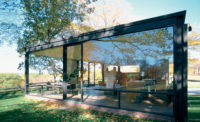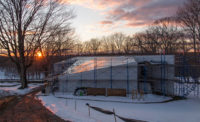Review of 'The Man in the Glass House: Philip Johnson, Architect of the Modern Century'
By Mark Lamster

The Man in the Glass House: Philip Johnson, Architect of the Modern Century, by Mark Lamster. Little, Brown and Company, 457 pages, $35.
Philip Johnson was both an evangelist for modern architecture and a political propagandist for evil. Shielded by personal wealth, he reinvented himself many times over as a curator, journalist, and architect of varying styles before dying in 2005, at age 98, inside the Glass House that remains the architect’s most celebrated building.
A quarter of a century ago, in his book Philip Johnson: Life and Work, art historian Franz Schulze laid bare the architect’s Nazi past, arguing that, in his political activities, Johnson was “decidedly unheroic” but that in the end he was “a trifler . . . a model of futility.” Now a new biography by Dallas Morning News architecture critic Mark Lamster passes tougher judgment on Johnson, for both his life and his work, finding a fundamental emptiness at the core of each.
Johnson was, Lamster concludes, “an unpaid agent of the Nazi state” who well into middle age was a virulent anti-Semite and a proponent of racist eugenics. In his book, Lamster quotes from the FBI files uncovered by Schulze and compiled after Johnson toured Eastern Europe in 1939 as a correspondent for rightwing U.S. papers at the invitation of Hitler’s propaganda ministry. As Johnson wrote of the Wehrmacht’s onslaught: “The German green uniforms made the place look gay and happy. There were not many Jews to be seen. We saw Warsaw burn and Modlin being bombed. It was a stirring spectacle.” Although Johnson later professed shame over such remarks, Lamster—like Schulze before him—questions the sincerity of the architect’s postwar acts of contrition, such as designing a synagogue in Port Chester, New York (1956), free, as well as a nuclear reactor in Israel (1959).
Several of Johnson’s designs come in for praise by Lamster, especially the early residential projects for wealthy clients, the Four Seasons Restaurant in Manhattan (1959), the plaza at New York’s Lincoln Center (1964), and the gallery addition at Dumbarton Oaks in Washington, D.C. (1963). But Lamster is highly critical of a string of his other projects like the JFK memorial in Dallas (1970), the library at New York University (1973), and the addition to the Boston Public Library (1973). Johnson’s Postmodern period, during which he helped reshape the American urban skyline, is blasted as “an architecture of staggeringly indelicate historical detailing slapped onto leaden structures that made negative contributions to civic space.”
In examining Johnson’s career, which began with low-key, elegant private houses and concluded with bombastic, tawdry schemes for Donald Trump, Lamster provides a survey of highprofile 20th-century U.S. architectural practice and how it was received by influential critics at The New York Times—Ada Louise Huxtable, Paul Goldberger, and Herbert Muschamp, all of whom Johnson assiduously cultivated for his own ends, with varying degrees of success.
Even if Johnson is recalled as a kingmaker in the architectural profession, the author dismisses much of his built legacy. Johnson also gained a posthumous reputation for generosity by making large bequests of artwork from his private collection to the Museum of Modern Art, but Lamster finds that Johnson showed “an essential cowardice and an appalling lack of interest in the welfare of others.”
“I can’t stand truth. It gets so boring, you know, like social responsibility,” Johnson states in an unattributed quote. Lamster’s biographical subject never fully recovers from his own declaration in this thoroughly researched and highly readable volume that vividly captures the essence of a complex and disturbing character.






